
304 CHAPTER 13. MATRICES AND THE INNER PRODUCT
Proof: Use block multiplication to write(AB 0B 0
)(I A0 I
)=
(AB ABAB BA
)(
I A0 I
)(0 0B BA
)=
(AB ABAB BA
).
Therefore, (I A0 I
)−1(AB 0B 0
)(I A0 I
)=
(0 0B BA
)Since the two matrices above are similar it follows that(
0 0B BA
)and (
AB 0B 0
)have the same characteristic polynomials. Therefore, noting that BA is an n×n matrix andAB is an m×m matrix,
tm det(tI−BA) = tn det(tI−AB)
and so det(tI−BA) = pBA (t) = tn−m det(tI−AB) = tn−m pAB (t). ■
13.2.2 Orthonormal Bases, Gram Schmidt ProcessNot all bases for Fn are created equal. Recall F equals either C or R and the dot product isgiven by
x ·y≡ (x,y)≡ ⟨x,y⟩= ∑j
x jy j.
The best bases are orthonormal. Much of what follows will be for Fn in the interest ofgenerality.
Definition 13.2.5 Suppose {v1, · · · ,vk} is a set of vectors in Fn. It is an orthonormal set if
vi ·v j = δ i j =
{1 if i = j0 if i ̸= j
Every orthonormal set of vectors is automatically linearly independent.
Proposition 13.2.6 Suppose {v1, · · · ,vk} is an orthonormal set of vectors. Then it is lin-early independent.
Proof: Suppose ∑ki=1 civi = 0. Then taking dot products with v j,
0 = 0 ·v j = ∑i
civi ·v j = ∑i
ciδ i j = c j.
Since j is arbitrary, this shows the set is linearly independent as claimed. ■It turns out that if X is any subspace of Fm, then there exists an orthonormal basis for
X . This follows from the use of the next lemma applied to a basis for X .